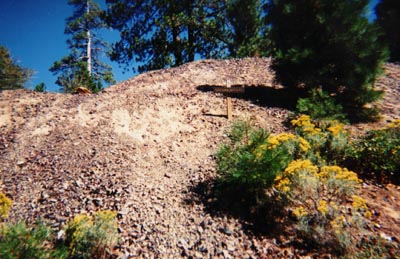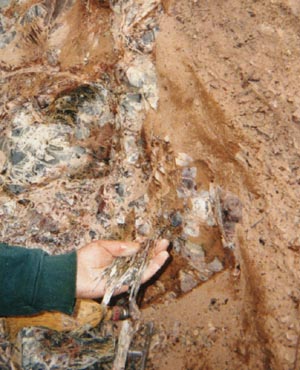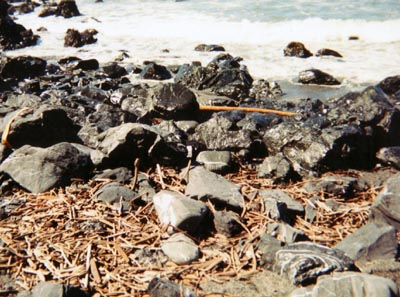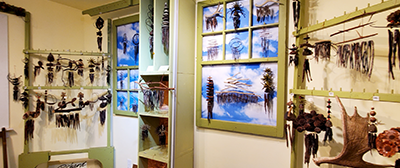
Our chimes begin with lava, which flows from a volcano. Lava is molten rock. It can take many forms depending on the mix of elements in a given batch and the way and rate at which it cools. It is just a bit like baking cookies. Different ingredients make different flavors. How the cookies are baked will affect the texture; but with lava, it is the cooling rather than the baking that helps defines the nature of the end product. For instance, granite, basalt and obsidian all come from roughly the same kind of 'dough'. The difference is that granite is formed when lava, (or magma as it is called before it reaches the earths surface), is injected below the surface, and therefore cools very slowly due to the insulating effect of the surrounding rock. Under these conditions the various minerals will crystallize or 'freeze' at different temperatures. They will grow to a size that may easily be seen by the naked eye. What happens in the formation of basalt is not much different except that it is extruded upon the earths surface and cools much more quickly than granite; hence, the crystals have less time to grow and are much smaller, requiring a magnifying glass to see; obsidian, however, is quite different. Because it cools rapidly, there is no time for any crystals to form at all. Each molecule is like a separate entity floating within the rock. With no interlocking crystalline structure to reinforce itself, it becomes a glass. There is research that indicates that obsidian behaves like a very, very thick liquid. The important thing in terms of obsidian being perfect for chimes is that the absence of crystal boundaries means that sound waves can travel through the rock without interference, and its ringing properties are greatly enhanced.
The term 'needles of obsidian' refers to a naturally occurring fragment of obsidian that is basically rod like in shape. Needles can be any where from the size of a pencil lead to that of a three-foot section of four-by-four.

As obsidian cools beyond the threshold of crystallization, it contracts and fractures. Usually the pattern of shattering is pretty random, creating pieces of varying size and shape. In any large obsidian flow there may be a few long thin pieces just because of chance. In a few flows, however, the entire formation has an over all tendency to produce needles. No one has ever seen this occur, so theories as to the origin of needles are only that: theories. The one that I favor, which was developed by an actual geologist from Humboldt University some twenty-five years ago, is that the needles formed in an already existing obsidian flow when it was bisected by a fault line. The resulting earth movement flaked the rock along parallel axis at 90 degrees, the result being needles. At every site where I have found more than random needles, there seems to be a general matrix with needle sizes ranging from hair-like to honkers of up to thirty inches; but please, feel free to come up with a theory of your own. Perhaps they were left by aliens or are some kind of weird communist plot. At any rate the needles are the second key to the wonderful and amazing tones that our chimes produce. The shapes allow the sympathetic vibrations to build up and emote.
Needles of obsidian are relatively rare and little known. Over the years, we have found several places in Oregon and California where we are permitted to dig them, and we enjoy primitive camping, hiking and digging for six to eight weeks per year.

While the sound of the obsidian is the critical element of our chimes, we also delight in the abundance of plant matter for creating beautiful objects of art.
There are many lovely and wild beaches along the northern pacific coast, and we can be found during several weeks of the year, hiking and combing the coastline, finding treasures of driftwood and cones to combine with obsidian. Occasionally, we have found interesting bones of fish, whales, seals and other sea creatures.

Nature also provides an incredible array of shapes, sizes and colors of seedpods and cones. We particularly favor those of Australian and African origins for their durability as well as their unique structures. There are abundant varieties of protea, banksias and eucalyptus. Many of these grow in southern California, and we are able to gather and select a wonderful variety several times a year when we are in the vicinity. We have also found like-minded foragers who gather for us. We often have one-of-a-kind pieces in our exhibits at art festivals and garden shows.
All materials we use are collected with a reverence for balance in Nature. Everything we use is in abundance and/or replenishable, with little or no impact on the environment. We consider our materials "on loan." While they are durable and long lasting as chimes, they are unpreserved and will eventually go back to the earth where they came from.

